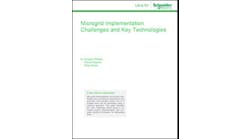Microgrid developers often lament the lack of standardization in the development process. Now a California non-profit says it has found a model for moving solar microgrids forward based on some successful projects including a microgrid project for the Santa Barbara schools.
The Clean Coalition — which seeks to bring clean energy, including microgrids, online — is seeing higher than anticipated savings related to its solar microgrids at the Santa Barbara Unified School District and recently completed a feasibility study for East Los Angeles that calls for three solar microgrids.
Clean Coalition is now eyeing getting community microgrids up and running in East L.A. and Santa Barbara. The community microgrids would incorporate the solar microgrids that are now now operating in Santa Barbara and those planned for East L.A.
Ripe opportunities for solar microgrids
To get solar microgrids deployed, the organization uses a standardized process for evaluating projects. This strategy involves identifying “ripe” opportunities to create solar microgrids, and having Clean Coalition serve as technical facilitators, providing feasibility and economic studies. The organization also works with stakeholders to help them take action, said Craig Lewis, founder and executive director, Clean Coalition.
Projects often begin with cities or towns approaching the Clean Coalition for feasibility studies, he said.
The standard process includes five steps:
1. Developing profiles for existing electricity loads and analyzing the loads for expected changes due to EV charging, new construction and electrification. This also involves developing profiles for critical loads that need to be met temporarily or indefinitely.
2. Creating resource scenarios that look at all possible onsite energy options.
3. Developing site layouts to illustrate suggested locations and sizing for generation resources.
4. Analyzing the costs and benefits of the resource scenarios.
5. Sharing the results and recommendations through presentations, reports and meetings.
A key part of the fourth step is using a standardized method of valuing resilience to help stakeholders identify the benefits of keeping electricity flowing during outages. The method looks at the value of resilience for three tiers of loads — critical, priority and discretionary loads.
In the East Los Angeles project, Clean Coalition valued resilience using four different approaches. The strategies included a cost-of-service approach, which is a standard utility approach to estimating how much it will cost to provide resilience. The organization also looked at a market approach, a federal Department of Energy process and an avoided diesel cost approach.
All the valuation methodologies yielded the same number, said Lewis. To provide the level of resilience a typical facility would design, the owner of the facility would be willing to pay a 25% adder, the organization found. This is the same cost as using diesel generation for resilience, said Lewis.
The Clean Coalition’s five-step process led to action at the Santa Barbara Unified School District. Solar microgrids are now up and running at 11 sites and three more are being built over the summer, said Lewis.
How Santa Barbara saved money
Two years ago, the coalition modeled the Santa Barbara project assuming that utility rates would be increasing by 3% per year, but the utility has been increasing rates 8% to 10% per year, with hikes expected to continue due to wildfire liabilities and wildfire mitigation efforts. That will result in higher than anticipated savings, said Lewis.
The East Los Angeles project involved a feasibility study of solar microgrids located at three critical community facilities: The Edward R. Roybal Health Center, East Los Angeles Civic Center and East Los Angeles Library. Clean Coalition’s feasibility study showed significant economic, environmental and resilience benefits, according to a summary of the study. The microgrids are now being staged for a request for proposals from developers.
Adding the solar microgrids to the three critical facilities will help support disadvantaged citizens in the community. The area scores 90 on a scale of one to 100 that identifies low-income neighborhoods, said Lewis.
$3.4 million in savings for Los Angeles County
The East Los Angeles study concluded that a fixed-rate $.17/kWh power purchase agreement (PPA) for the microgrids would result in $3.4 million in bill savings over 25 years for Los Angeles County. In addition, the county would receive resilience worth $1.7 million. The county could earn additional money by using the microgrids to provide grid services and electric vehicle charging, according to the summary.
Clean Coalition recommended a PPA because the county couldn’t take advantage of tax credits, so it made more sense for a third party to own the project and utilize the tax benefits, said Lewis.
The feasibility study called for the county to issue a request for proposals to deploy the solar microgrids. In addition, Clean Coalition suggested that the county begin talking to Southern California Edison (SCE) about a possible community microgrid for the area.
Why community microgrids are hard
But getting community microgrids up and running is a challenge due to utility roadblocks, said Lewis.
A community microgrid — which would use utility distribution lines to move power through a neighborhood—would require grid isolation switches allowing the microgrid to isolate from the grid. And those would have to be approved by the utility.
“If the utility won’t let you put grid isolation switches in there, there’s no way to get from facility A to facility B along the same feeder segment,” Lewis said.
But that doesn’t mean the Clean Coalition has given up on community microgrids.
The organization has identified a vision to move community microgrids along. And its efforts deploying solar microgrids in Santa Barbara, Los Angeles County and other areas are part of the plan. A key is working with utilities.
It’s not impossible to partner with utilities, Lewis said. The Redwood Coast Airport Microgrid, a multi-customer microgrid in northern California, is an example. It’s the first front-of-meter multi-customer microgrid in northern California and is being developed along with Pacific Gas & Electric. It’s expected to provide learnings that can inform others interested in developing community microgrids.
A community microgrid in Los Angeles County would include a whole neighborhood, said Lewis.
“If we can get SCE to play along, we will turn (the East Los Angeles project) into a true community microgrid.” And that will provide even more economic, environmental and resilience benefits than the three solar microgrids are expected to reap, he said.
Track news about solar microgrids. Subscribe to the free Microgrid Knowledge Newsletter.








